Notes: Holywell Town station was the southern terminus of the 1¾-mile branch which connected to the Chester and Holyhead main line at Holywell Junction (Holywell until 1 July 1912). Holywell Town was opened with the branch by the London & North Western Railway on 1 July 1912. Much of the course of the branch had previously been part of the Holywell Railway (HR) which had opened in 1867 (along the route of an existing tramway). The HR had provided a link between an industrial area to the north of Holywell and a harbour at Greenfield on the River Dee. By the late 1870s many of the industries had ceased and consequently the railway went into receivership, as a result of which the line closed and was lifted. The HR route was purchased by the LNWR in 1891. For many years the company debated what should be done with it and even considered an electric 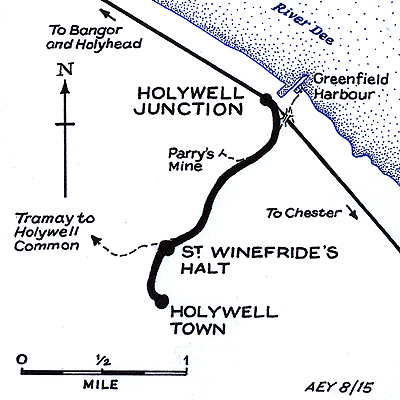 tramway. In 1905, having previously operated a steam lorry service between the main line station and the town, the LNWR introduced a motor bus service between Holywell Junction and Holywell Town. It was a success and encouraged the LNWR to obtain an Act to reopen the HR. New sections of line were built between the old alignment and Holywell Junction station and between St Winefride’s and Holywell Town. It was built as a single-track railway with no passing loops. An intermediate halt was provided on the line at St Winefride’s. tramway. In 1905, having previously operated a steam lorry service between the main line station and the town, the LNWR introduced a motor bus service between Holywell Junction and Holywell Town. It was a success and encouraged the LNWR to obtain an Act to reopen the HR. New sections of line were built between the old alignment and Holywell Junction station and between St Winefride’s and Holywell Town. It was built as a single-track railway with no passing loops. An intermediate halt was provided on the line at St Winefride’s.
The line was very steeply graded having sections up to 1 in 27. The station at Holywell Town was located in a steep sided cutting just to the north of the town centre. Because of the hilly terrain the station had an unusual layout. Access to the single platform, south-west of the railway, was via a sloping path from an overbridge that spanned the line. Two simple wooden shelters provided booking and waiting facilities. A running-in nameboard was located at the north end of the platform and the station was lit by gas.
The goods facilities at Holywell Town were north of the overbridge and east of the main line. Because a flat site had to be created for the yard it was at a higher elevation than the branch that passed to its west and access into it was via the passenger station. The line became double just to the north of the platform and singled again for a very short distance just to the south-east. The north-east side line (not served by the platform) was used by goods trains. Leading off it from a point on the north side of the overbridge were two sidings that extended into the goods yard. The yard had a large loading area, a lifting crane, a wooden goods shed and a brick-built goods office. Road access was via a sloping driveway that led up to the overbridge on the east side of the line.
Only one train was allowed onto the branch at any time so no signals were required at Holywell Town. All of the points at the station were hand-worked.
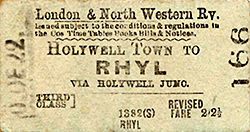 Passenger trains operated as a shuttle between Holywell Town and Holywell Junction. A powerful LNWR 0-6-2 tank engine was employed on the branch. It was coupled to two coaches and positioned at the Holywell Junction end of the train. This meant that it pushed the coaches up the steeply gradient to Holywell Town and on the return journey it could hold them in check when going downhill. Passenger trains operated as a shuttle between Holywell Town and Holywell Junction. A powerful LNWR 0-6-2 tank engine was employed on the branch. It was coupled to two coaches and positioned at the Holywell Junction end of the train. This meant that it pushed the coaches up the steeply gradient to Holywell Town and on the return journey it could hold them in check when going downhill.
In 1913 a lift was installed that connected the platform to the overbridge. The lift was installed to facilitate the transfer of parcels and other light goods between the station and the town.
The passenger service proved popular and by July 1922 there were eighteen departures and eighteen arrivals serving the station Monday-to-Saturday. There was no sunday service.
On 1 January 1923 Holywell Town became part of the London Midland & Scottish Railway (LMS).
An intensive service of trains continued to run during the LMS years. The summer timetable for 1932 showed twenty-three trains in each direction Monday-to-Friday. There was an extra train on Wednesdays. On Saturdays there were twenty-five trains each way but there were still no trains on Sundays.
During the Second World War there was a reduction to the service which did not recover once hostilities had ceased. The last timetable produced by the LMS in the summer of 1947 showed fifteen arrivals and fifteen departures on Monday-to-Friday. On Saturdays there were twenty trains in each direction.
On 1 January 1948 Holywell Town became part of British Railways [London Midland Region] (BR[LMR]). The first timetable issued by BR(LMR) on 31 May 1948 is shown below. It shows an extra train each way Monday-to-Friday and two extra trains on Saturdays.
The service level in the summer1953 timetable had dropped back to fifteen trains each way Monday-to-Friday with nineteen on Saturdays. This was still a good level of service for a rural branch line but in 1954 BR[LMR] published its intention to withdraw all services between Holywell Town and Holywell Junction.
The final summer timetable with effect from 14 June 1954 showed only five trains in each direction on weekdays. There was a better service on Saturdays with ten arrivals and nine departures.
The last passenger trains ran on Saturday 4 September 1954. The station closed completely on 6 September 1954.
After closure the station was demolished and the line was lifted. The station site was later developed into a parkland area and the branch became a footpath.
Tickets by Michael Stewart, timetable from and route map by Alan Young
Sources:
- A Regional History of the Railways of Great Britain - Volume 11 - North & Mid Wales, Peter E Baughan, David & Charles 1980.
- Chester to Holyhead - The Branch Lines, Bill Rear, Oxford Publishing Company 2003.
See also: St Winefride's Halt and Holywell Junction |

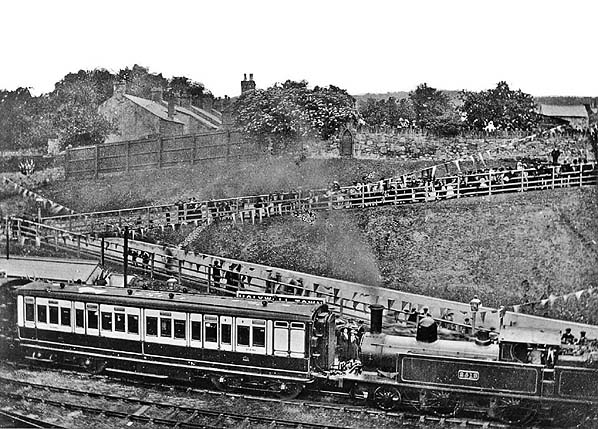


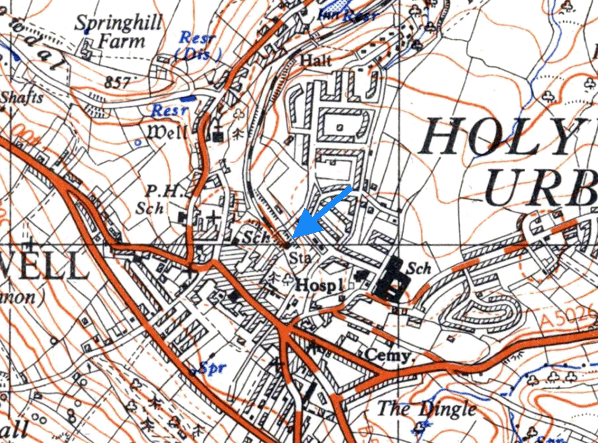

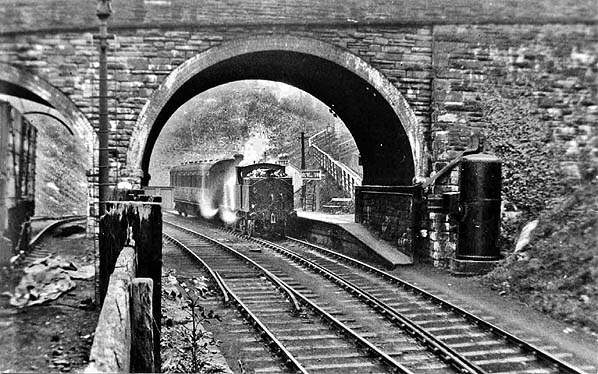

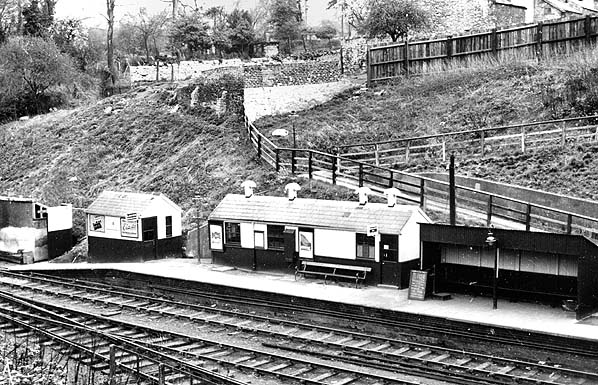
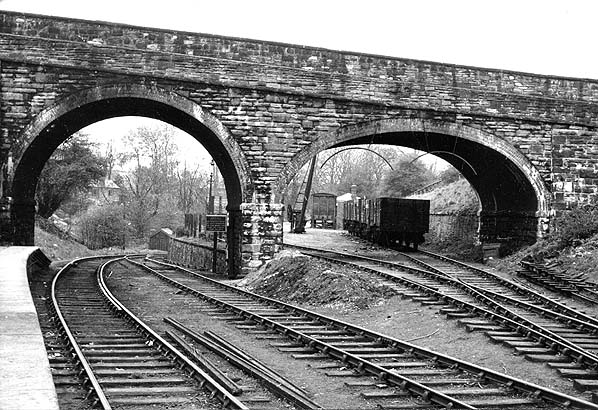
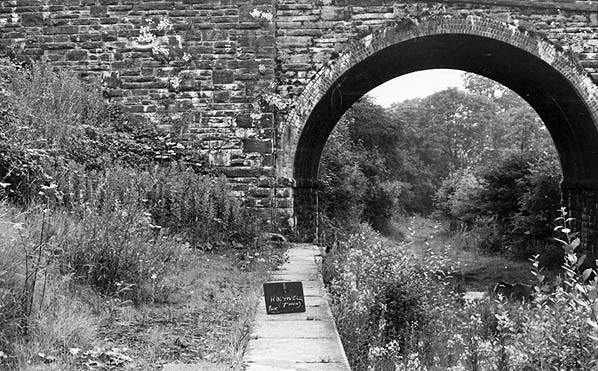
.jpg)
 tramway. In 1905, having previously operated a steam lorry service between the main line station and the town, the LNWR introduced a motor bus service between Holywell Junction and Holywell Town. It was a success and encouraged the LNWR to obtain an Act to reopen the HR. New sections of line were built between the old alignment and Holywell Junction station and between St Winefride’s and Holywell Town. It was built as a single-track railway with no passing loops. An intermediate halt was provided on the line at St Winefride’s.
tramway. In 1905, having previously operated a steam lorry service between the main line station and the town, the LNWR introduced a motor bus service between Holywell Junction and Holywell Town. It was a success and encouraged the LNWR to obtain an Act to reopen the HR. New sections of line were built between the old alignment and Holywell Junction station and between St Winefride’s and Holywell Town. It was built as a single-track railway with no passing loops. An intermediate halt was provided on the line at St Winefride’s.  Passenger trains operated as a shuttle between Holywell Town and Holywell Junction. A powerful LNWR 0-6-2 tank engine was employed on the branch. It was coupled to two coaches and positioned at the Holywell Junction end of the train. This meant that it pushed the coaches up the steeply gradient to Holywell Town and on the return journey it could hold them in check when going downhill.
Passenger trains operated as a shuttle between Holywell Town and Holywell Junction. A powerful LNWR 0-6-2 tank engine was employed on the branch. It was coupled to two coaches and positioned at the Holywell Junction end of the train. This meant that it pushed the coaches up the steeply gradient to Holywell Town and on the return journey it could hold them in check when going downhill. 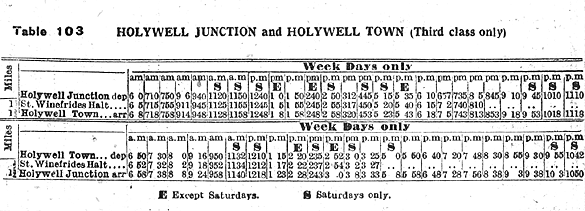
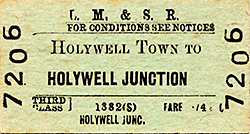
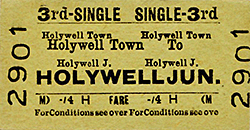

 Home Page
Home Page